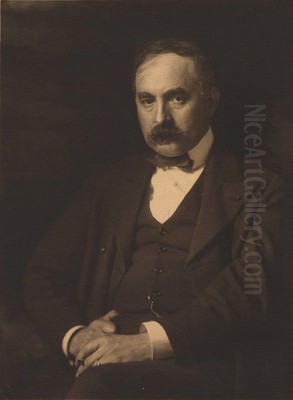
Julius Garibaldi "Gari" Melchers stands as a prominent figure in American art, a painter whose career bridged the late 19th and early 20th centuries. His work, characterized by its robust naturalism, sensitive portrayal of human subjects, and masterful use of color and light, earned him international acclaim. Melchers was a cosmopolitan artist, trained in Europe and deeply influenced by its traditions, yet he remained distinctly American in his perspective and thematic choices. His life and art reflect the artistic currents of his time, from academic realism to the burgeoning influences of Impressionism and Post-Impressionism, all while maintaining a unique and personal vision.
Early Life and Artistic Awakening
Born on August 11, 1860, in Detroit, Michigan, Gari Melchers was the son of German-born sculptor Julius Theodore Melchers and Marie Bangetor. His father, a respected artist and craftsman in his own right, provided Gari with his earliest artistic instruction. This familial immersion in the arts undoubtedly shaped young Gari's inclinations. Recognizing his son's talent and ambition, Julius Theodore supported Gari's desire to pursue formal art training abroad, a common path for aspiring American artists of that era seeking to immerse themselves in the established European art academies.
At the tender age of 17, in 1877, Gari Melchers embarked for Germany. He enrolled at the prestigious Royal Academy of Art in Düsseldorf, a city then renowned for its rigorous academic training. At the Academy, he studied under Eduard von Gebhardt, a notable painter of historical and religious subjects. The Düsseldorf school emphasized meticulous draftsmanship, anatomical accuracy, and a somewhat somber palette, all of which would form a solid foundation for Melchers' later work. He spent four formative years there, absorbing the disciplined techniques and artistic philosophies prevalent in German academic circles.
The Parisian Crucible and Early Success
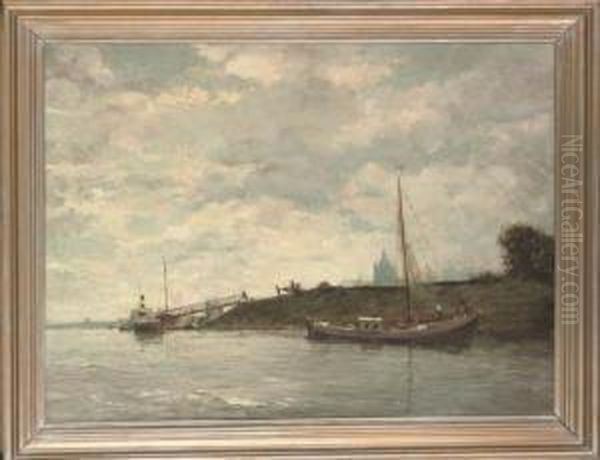
Seeking broader artistic horizons, Melchers moved to Paris in 1881. The French capital was the undisputed center of the art world, a vibrant hub of innovation and tradition. He enrolled at the Académie Julian, a popular alternative to the more rigid École des Beaux-Arts, studying under Gustave Boulanger and Jules Joseph Lefebvre. Both were highly respected academic painters, known for their polished technique and classical subjects. Melchers also attended classes at the École des Beaux-Arts itself, further steeping himself in the French academic tradition.
Paris exposed Melchers to a wider range of artistic influences than Düsseldorf. While academic training remained paramount, the air was also thick with the revolutionary ideas of Impressionism and the burgeoning Post-Impressionist movements. Artists like Jules Bastien-Lepage, with his naturalistic depictions of peasant life, made a significant impact on Melchers and many of his contemporaries. Bastien-Lepage's approach, combining academic drawing with a more truthful observation of rural subjects and a lighter palette, offered a compelling alternative to purely historical or mythological themes.
Melchers' talent quickly gained recognition. In 1882, his painting "The Letter" was accepted at the prestigious Paris Salon, a significant achievement for a young artist. This early success signaled his arrival on the competitive Parisian art scene and bolstered his confidence. His works from this period often depicted everyday scenes and figures with a sympathetic yet unsentimental eye, reflecting the growing interest in realism and naturalism.
The Egmond Years: Defining a Style
In 1884, Melchers, along with his friend and fellow American painter George Hitchcock, established a studio in Egmond aan Zee, a small fishing village on the North Sea coast of Holland. This move proved to be a pivotal moment in his career. The Dutch landscape, the local culture, and particularly the quality of light in Holland profoundly influenced his artistic development. He was drawn to the simple, hardworking lives of the Dutch peasants and fisherfolk, finding in them a dignity and authenticity that resonated with his artistic sensibilities.
During his years in Egmond, which extended for over two decades with intermittent stays elsewhere, Melchers produced some of his most iconic works. Paintings such as "The Sermon" (1886), depicting Dutch villagers in a church, garnered him international acclaim, including a Grand Prix at the Paris Exposition Universelle of 1889. This painting, notable for its strong composition, sensitive character studies, and harmonious color scheme, exemplified his mature style: a blend of academic solidity, naturalistic observation, and a deep empathy for his subjects. Other important works from this period include "The Pilots" and "The Skaters," which further explored themes of Dutch life.
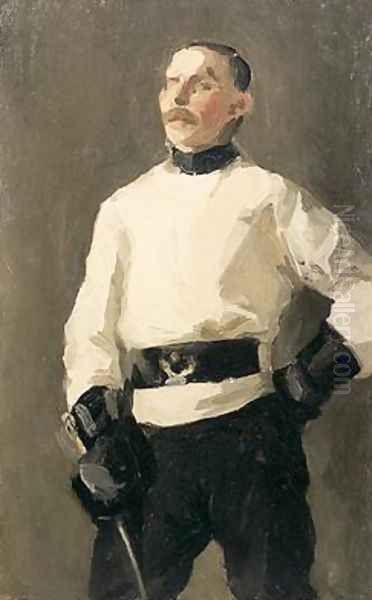
His Dutch paintings often featured strong, sculptural figures, a clear, diffused light, and a palette that, while often subdued, was capable of great subtlety and richness. He was particularly adept at capturing the textures of fabrics, the character in a weathered face, and the quietude of domestic or communal interiors. His work in Holland aligned him with the broader European interest in peasant themes, seen in the work of artists like Jean-François Millet in France, but Melchers brought his own distinctively American pragmatism and directness to the subject.
International Acclaim and Mural Commissions
By the 1890s, Gari Melchers was an internationally celebrated artist. He exhibited widely in Europe and the United States, receiving numerous awards and honors. His reputation as a leading figure painter was firmly established. This period saw him undertake significant mural commissions, a popular form of public art during the American Renaissance. One of his most notable mural projects was for the World's Columbian Exposition in Chicago in 1893, where he contributed to the decoration of the Manufactures and Liberal Arts Building.
Perhaps his most famous murals are "War" and "Peace," completed in 1896 for the Library of Congress in Washington, D.C. These allegorical compositions, grand in scale and conception, demonstrated his ability to work in a monumental format and engage with classical themes, yet imbue them with a modern sensibility. These commissions placed him in the company of other leading American muralists of the day, such as John La Farge, Edwin Howland Blashfield, and Kenyon Cox, who were all contributing to the decoration of significant public buildings across the United States.
His portraiture also gained prominence during this time. He painted prominent figures on both sides of the Atlantic, including Theodore Roosevelt. His portraits were known for their psychological insight and strong characterization, avoiding flattery in favor of a more direct and honest representation. This approach was similar to that of other great portraitists of the era, such as John Singer Sargent, though Melchers' style was generally more solid and less overtly bravura.
A Transatlantic Career: Weimar and the Return to America
In 1903, Gari Melchers married Corinne Lawton Mackall, a young art student from Baltimore who had studied in Paris. She became his muse, model, and lifelong companion. Her presence is felt in many of his later works, particularly those depicting domestic scenes and motherhood, such as the tender "Maternity" series.
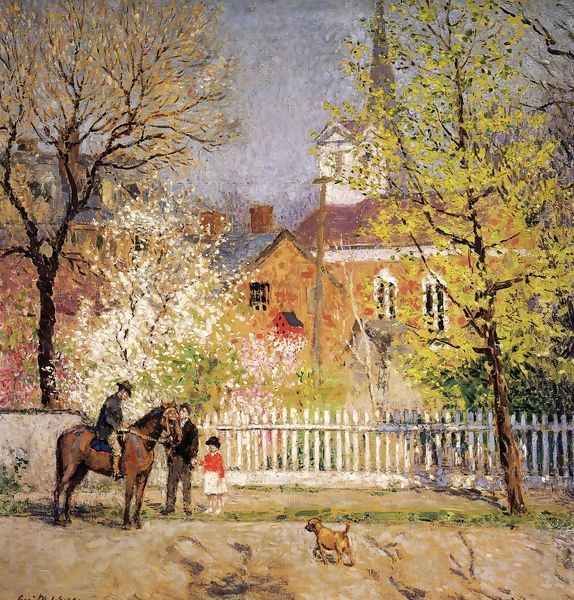
From 1909 to 1914, Melchers accepted a position as Professor of Painting at the Grand Ducal Saxon School of Art in Weimar, Germany. This was a prestigious appointment, and he influenced a generation of German art students. During his time in Weimar, he continued to paint and exhibit, his style evolving subtly, sometimes incorporating brighter colors and a looser brushwork, perhaps reflecting a quiet absorption of Impressionist and Post-Impressionist aesthetics, though he never fully abandoned his foundational realism. Artists like Max Liebermann, a leading German Impressionist, were active during this period, and the artistic environment in Germany was dynamic.
The outbreak of World War I in 1914 compelled Melchers and his wife to leave Germany. As an American citizen, his position became untenable. They returned to the United States in 1915, initially settling in New York City. The war marked a significant turning point, effectively ending his long expatriate period in Europe and re-centering his life and career in his native country.
The Belmont Era: A Virginia Home and Studio
In 1916, Gari and Corinne Melchers purchased Belmont, an 18th-century estate in Falmouth, Virginia, near Fredericksburg. This historic property became their permanent home and Gari Melchers' final studio. The serene Virginia countryside, the historic house, and its gardens provided new inspiration for his work. He painted landscapes, portraits of local Virginians, and intimate domestic scenes featuring Corinne.
At Belmont, Melchers continued to work prolifically, adapting his style to his new surroundings. His palette sometimes brightened further, capturing the distinct light and atmosphere of the American South. Works from this period, such as "The Hunters" and "St. George's Church," reflect his engagement with his American environment. He remained an active figure in the American art world, serving on art juries and participating in exhibitions. He was elected to the National Academy of Design in 1906 and was a member of numerous other art societies.
Gari Melchers passed away at Belmont on November 30, 1932, at the age of 72. He left behind a significant body of work and a reputation as one of America's foremost painters of his generation. His wife, Corinne, continued to live at Belmont and worked to preserve his legacy, eventually bequeathing the estate and its contents, including many of his paintings and his studio, to the Commonwealth of Virginia. Today, Gari Melchers Home and Studio is a public museum and a National Historic Landmark, offering a unique insight into his life and art.
Artistic Style, Influences, and Techniques
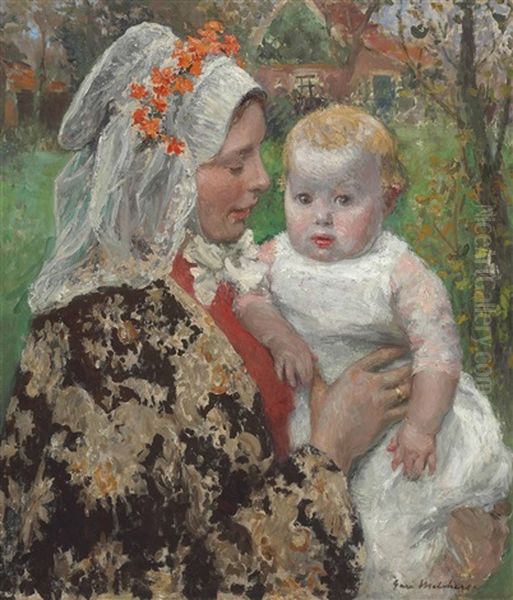
Gari Melchers' artistic style is primarily characterized as Naturalism or Realism, with an emphasis on strong draftsmanship, solid form, and a truthful depiction of his subjects. His early training in Düsseldorf instilled in him a respect for academic discipline, which remained a cornerstone of his art throughout his career. However, his exposure to French art, particularly the work of Jules Bastien-Lepage, encouraged a more direct engagement with contemporary life and a greater sensitivity to light and atmosphere.
While he was aware of Impressionism and its innovations, Melchers never fully embraced its tenets. He did not dissolve form into light and color in the manner of Claude Monet or Camille Pissarro. Instead, he selectively incorporated aspects of Impressionist technique, such as a brighter palette and more visible brushwork in his later works, particularly in his landscapes and outdoor scenes. His primary focus remained on the human figure, rendered with solidity and psychological depth.
The influence of the Dutch Masters, such as Johannes Vermeer and Rembrandt van Rijn, is evident in his Dutch period works, particularly in his handling of interior light and his sympathetic portrayal of ordinary people. He shared with these masters an appreciation for the quiet dignity of everyday life. His compositions were carefully constructed, often with a strong sense of design and balance, reflecting his academic training. He was a versatile artist, proficient in oil painting, watercolor, and mural work.
Key Works and Their Significance
Several paintings stand out as defining achievements in Gari Melchers' oeuvre:
"The Letter" (1882): An early success at the Paris Salon, this work demonstrates his emerging talent for capturing intimate, everyday moments with sensitivity and technical skill.
"The Sermon" (1886): Perhaps his most famous work from the Dutch period, it depicts a congregation in a rustic church. The painting is celebrated for its powerful composition, individualized character studies, and the palpable sense of piety and community. It won him international fame.
"Maternity" (c. 1895 and later versions): A recurring theme in his work, often featuring his wife Corinne, these paintings are tender and intimate portrayals of motherhood, rendered with a gentle realism and warm humanity. These works can be seen in dialogue with similar themes explored by artists like Mary Cassatt, though Melchers' approach was less Impressionistic.
"The Pilots" (1887): Another strong depiction of Dutch working life, showcasing his ability to capture the rugged character of his subjects and the atmospheric conditions of the North Sea coast.
"Penelope" (1910): A more classical subject, this painting shows his wife Corinne in a thoughtful pose, weaving. It combines his skill in figure painting with a rich, decorative quality, possibly influenced by Symbolist currents or the work of artists like James McNeill Whistler.
"War" and "Peace" (1896): His murals for the Library of Congress are monumental achievements, demonstrating his mastery of large-scale allegorical composition and his contribution to the American Renaissance.
"The Fencing Master" (1900-1905): A dynamic portrait that captures the intensity and grace of the sport, showcasing his skill in depicting movement and character.
These works, among many others, illustrate the breadth of Melchers' talent, from intimate genre scenes and portraits to grand public murals.
Melchers and His Contemporaries
Gari Melchers was part of a generation of American artists who sought training in Europe and achieved international recognition. He was a contemporary of figures like John Singer Sargent, James McNeill Whistler, William Merritt Chase, Childe Hassam, Frank Duveneck, and Cecilia Beaux. While each of_these artists developed a unique style, they shared a common experience of navigating between European traditions and an emerging American artistic identity.
Melchers' relationship with George Hitchcock was particularly significant during their time in Egmond. Together, they formed the nucleus of a small artists' colony. His work can be compared to that of other artists who painted peasant life, such as Léon Lhermitte in France or Max Liebermann in Germany. In America, his commitment to realism and figure painting aligned him with artists like Thomas Eakins and Winslow Homer, though Melchers' European training and experiences gave his work a distinct international flavor. He was respected by his peers and played an active role in art organizations, contributing to the professionalization of the art world in the United States.
Legacy and Collections
Gari Melchers' legacy is that of a dedicated and highly skilled painter who remained true to his artistic vision throughout a period of rapid change in the art world. While modernist movements gained ascendancy in the early 20th century, Melchers continued to champion a form of representational art rooted in observation and craftsmanship. His work provides a valuable link between 19th-century academic traditions and 20th-century realism.
His paintings are held in numerous prestigious museum collections worldwide, including:
Gari Melchers Home and Studio (Belmont), Falmouth, Virginia (the largest single collection)
Detroit Institute of Arts, Detroit, Michigan
Smithsonian American Art Museum, Washington, D.C.
The Metropolitan Museum of Art, New York
Art Institute of Chicago, Chicago, Illinois
Musée d'Orsay, Paris, France
Telfair Museums, Savannah, Georgia
Pennsylvania Academy of the Fine Arts, Philadelphia, Pennsylvania
Corcoran Collection, National Gallery of Art, Washington, D.C.
Major exhibitions of his work have been held throughout his career and posthumously, reaffirming his status as a significant American artist. His home and studio at Belmont serve as a vital center for the study and appreciation of his art, preserving his working environment and personal effects.
Personal Glimpses and Anecdotes
One interesting detail is his name: born Julius Garibaldi Melchers, he adopted "Gari" as his professional name, a more distinctive and perhaps less formal moniker. His father, Julius Theodore Melchers, was a Westphalian sculptor who had worked for Carpeaux and Cordier in Paris before emigrating to Detroit, where he became a prominent architectural sculptor and woodcarver. This artistic lineage clearly provided a strong foundation.
Melchers was known for his dedication to his craft and his methodical approach to painting. His studio at Belmont, preserved as he left it, reveals his organized working methods. Despite his international fame, he was described as a modest and unassuming man. His marriage to Corinne Mackall was a source of great happiness and stability, and she frequently appears as a model in his paintings, embodying grace and domesticity.
His decision to purchase and restore Belmont in Virginia reflected a desire to connect with American history and establish roots in his native country after years abroad. The estate became not just a home but an integral part of his artistic identity in his later years. He took an active interest in the local community and the preservation of the region's heritage. There are no major "controversies" associated with Melchers; he was a respected professional who navigated the art world with integrity. His return to the U.S. due to World War I was a significant life event, redirecting his career path and personal life.
Conclusion
Gari Melchers was a pivotal artist who successfully synthesized European academic training with an American sensibility. His depictions of Dutch peasant life, his insightful portraits, his tender domestic scenes, and his grand murals all attest to his technical mastery and his profound humanism. He navigated the shifting artistic landscape of the late 19th and early 20th centuries with a consistent commitment to representational art, creating a body of work that is both historically significant and enduringly appealing. His legacy is preserved not only in museums worldwide but also in his beautifully maintained home and studio at Belmont, offering a lasting testament to a distinguished American master.